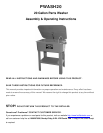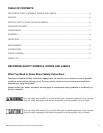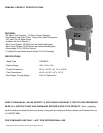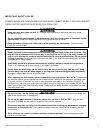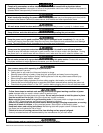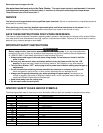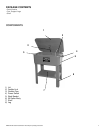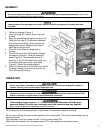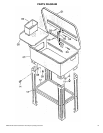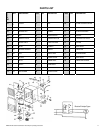
PWASH20 20 Gallon Parts Washer Assembly & Operating Instructions
9
MAINTENANCE
Disconnect the power supply before cleaning. Wear safety eyewear before cleaning.
A qualified repair technician must perform any tool service or repair. Service or maintenance
performed by unqualified personnel could result in injury. Use only identical replacement parts. Use of
unauthorized parts or failure to follow maintenance instructions may create a risk of electric shock or
injury.
Do not make contact with a grounded surface while using this power tool. Contact with surfaces like
pipes, radiators or major appliances increase your risk of electric shock.
Warning: Always unplug the Power Cord from the electrical outlet before performing any maintenance.
Replacing Cleaning Solution
1. Replace the cleaning solution when it becomes dirty.
2. Place an empty container on the lower Shelf that is large enough to hold all of the liquid which is
in the Body.
3. Remove the Plug from the bottom of the Body. The fluid should drain into the empty container on
the Shelf below.
4. Dispose of the used cleaning solution properly. Do not drain the cleaning solution into the street drains,
house drains, or into the earth. Contact your local waste management officials for proper disposal methods.
5. Replace the Plug then refill the Body with new cleaning solution.
When the cleaning solution flow is reduced or stopped, it may be necessary to clean the
Flexible Pipe (24).
Cleaning the Flexible Pipe and Impeller
1. Make certain that the indicator light on the Switch Box is on.
2. Turn the Switch to the OFF position.
3. Unplug the Power Cord from the electrical outlet.
4. Remove the Flexible Pipe from the Elbow. Drain the pipe, inspect its interior for debris. Use compressed air to
blow clean.
5. Remove the Pump Housing Cover by removing the Screws, then clear and remove any foreign matter
from the impeller.
6. Reattach the Flexible Pipe to the Elbow, and replace the Pump Housing Cover.
ACCESSORIES
Use only accessories that are recommended by the manufacturer for your model. Accessories that may be suitable
for one tool may become hazardous when used on another tool.
Always attach grounded (3-prong) extension cords to grounded (3-prong) outlets.
If you must use an extension cord, be sure that the gauge is large enough to carry the amount of current
necessary for your power tool. If not, your tool may experience a loss of power, excessive voltage drop or overheating.
For example, the smaller the gauge number, the heavier the cord.



